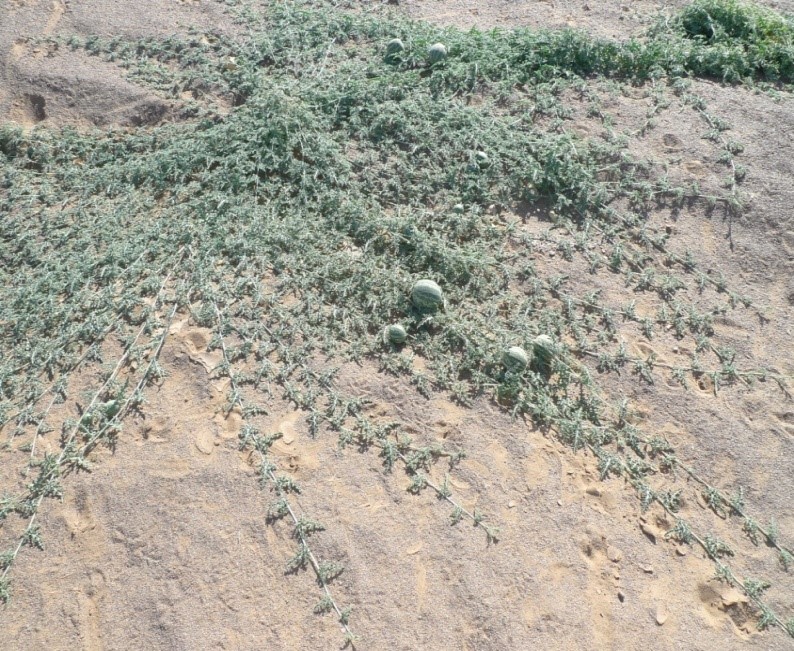
Citrullus colocynthis / حنظل
Colocynthis vulgaris Schrad. Cucumis colocynthis L.
Handal, Shary, Serew, Hanzal, Suri, Hedge
Colocynth, Bitter apple, Bitter gourd, Desert squash
Handal, Murrah, Shary, Serew, Hanzal, Suri, Hedge
Cucurbitaceae
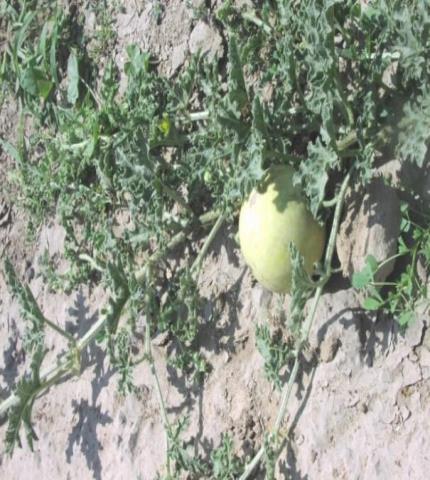
Fruit

Herbarium specimen
Ethnobotanical Characteristics
Description
The plants of this species are perennial, trailing herbs with a somewhat woody tuberous root. Stems shortly have short hairs when young becoming scabrid. Tendrils are simple, rarely bifid, slender, glabrous. Leaf blade is elongate-ovate in outline, 10-60 mm long, 8-55 mm broad, distinctly scabrid-hairy beneath, smooth except on the nerves above, palmate with deep 3-5 lobes, ultimate lobes are pinnate with central lobe longest and long-ovate in outline; petiolate, and petiole has dense rough-hairs. Probracts are lanceolate-elliptic, 4-5 mm long and l.5 mm broad, caducous. Male flowers are borne on long pedicels; calyx campanulate, 7 (4-8) mm long, lobes 5 mm broad; corolla pale yellow, ovate-acute, 8 mm long and 5 mm broad. Female flowers are on longer pedicels than male, receptacle-tube short, lobes lanceolate, 5 mm long. The ovary is hairy, subglobose or obovate. Fruit on a long stalk, 5 cm in diameter, globose, smooth, longitudinally green striped, 5-7 cm in diameter, epicarp thin, filled with a dry spongy, very bitter pulp. Numerous 6 mm long and3 mm wide seeds that are broad ovate-oblong, yellowish brown, not margined. (Jongbloed, 2003, Flora of Pakistan, Mandaville, 1990).
Habitat and Distribution
The plant is commonly found in patches in sandy places in the extensive blazing deserts of all the Arab countries (Ghazanfar, 1994). The plant is widespread in the U.A.E, except in the western and southern part of the country. The plants suffer in winter and recover again in summer. They have wonderful adaptation ability to grow upon the hot sandy soil of summer months where scarcely any plant can survive. The tap root is succulent and very deep (Batanouny, 1999).
Part(s) Used
Seed, seed oil
Traditional and Medicinal Uses
The leaves are diuretic and used in treatment of jaundice and asthma. The root is used against inflammation of breasts, amenorrhea, rheumatism, joint pains, externally in ophthalmia and uterine pains. The fruit is pungent, cooling, purgative, anthelmintic, antipyretic and carminative. It cures tumors, leucoderma, ulcers, asthma, bronchitis, urinary discharge, enlarged spleen, tuberculosis glands of the neck, dyspepsia, constipation, anaemia, and throat diseases. The fruit pulp is purgative, diuretic, antiepileptic, and anti-gonorrheal (Batanouny, 1999). The leaves, seeds, roots and dried fruit are used to treat dog, insect and snake bites, as a laxative, to relieve pain in joints and as a hair dye. Powdered leaves mixed with water are taken as a laxative; crushed roots are mixed with goat milk and used as a purgative and to treat colic. In Yemen the seeds, which are also used as a purgative, are mixed with other foods to reduce its strong laxative action. Seeds crushed with water are used as shampoo to darken hair colour and crushed fruit mixed with oil is rubbed to relieve pain in joints (Ghazanfar, 1994). Very powerful purgative or hydragogue cathartic, emetic and gastrointestinal irritant. It is usually given with Hyoscyamus to prevent gripping. It is not recommended for use in case of pregnancy. It stimulates hair growth (Fawzy Kotb, 1985)
Pharmacognosy and Phytochemistry
A transverse section of the seed shows that the seed coat (testa) consists of a thick palisade-like epidermal layer of long thickened cells of anticlinal walls having brown rod-like structures giving a characteristic flame-like appearance. The rod-like structures do not extend to the outer part of the testa. The inner side of this layer is adjacent to a grayish yellow layer of small sclerenchymatous cells with thick pitted walls. This is underlain by several other sclerenchymatous layers, which gradually become large, starting from the layer below the epidermis towards the central part of the seed. Larger sclerenchymatous cells have a yellow color, and they are strongly packed together, giving characteristic block-like structures. They are thickened with narrow longitudinally branching lumens. The yellow endospermic cells are polygonal and they contain oily droplets.
Powdered plant material
The material consists of the crushed seeds of the plant. It is a greasy yellow brown coarse gritty powder that has a slight characteristic odour and a very bitter persisting taste. Microscopically, the powder shown light brown thick sheet-like fragments of seed testa layers. It shown the testa palisade-like epidermal layer with brown rod-like structures having flame-like appearance in addition to isolated groups of light yellow small sclerenchyma cells of the testa; occasional individual cells are also observed. It also shows larger yellow-coloured sclerenchyma cells strongly packed and heavily thickened with narrow longitudinally branching lumens. Yellow endospermic cells are polygonal and they contain oily droplets.
Parts studied
seeds
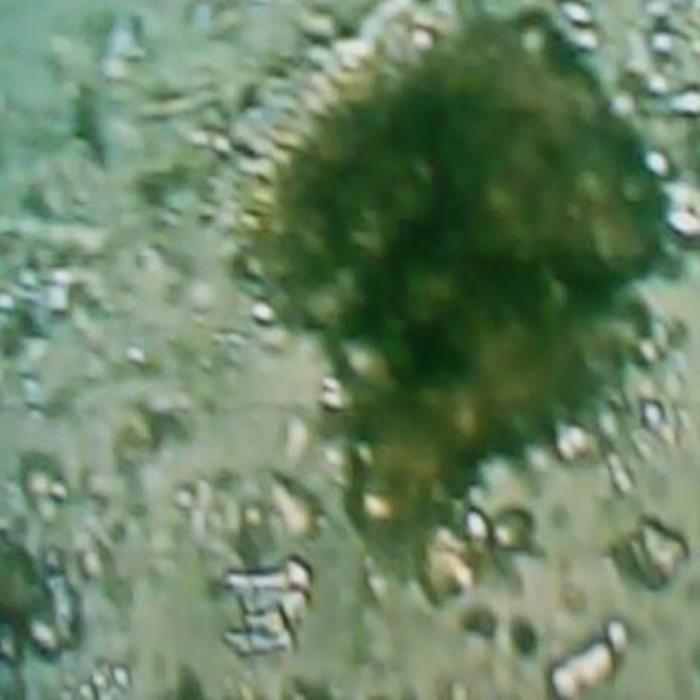
A) Seed testa
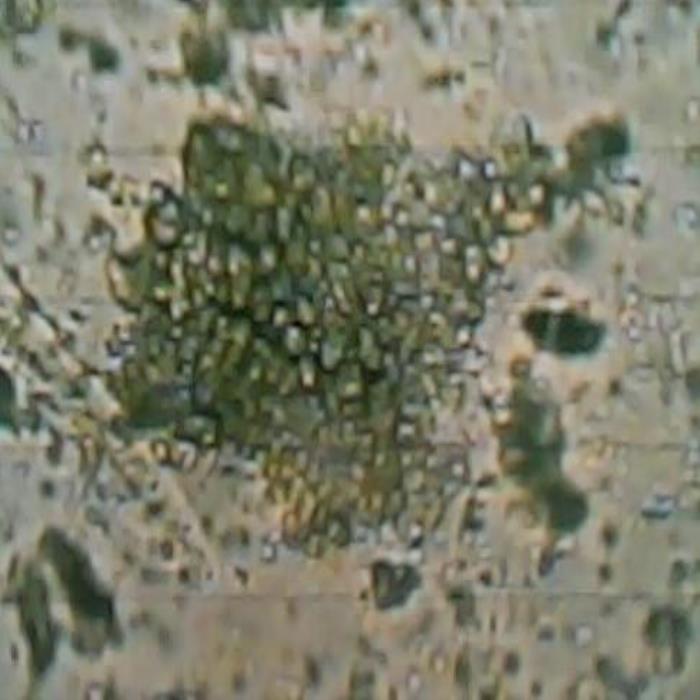
B) Seed endosperm
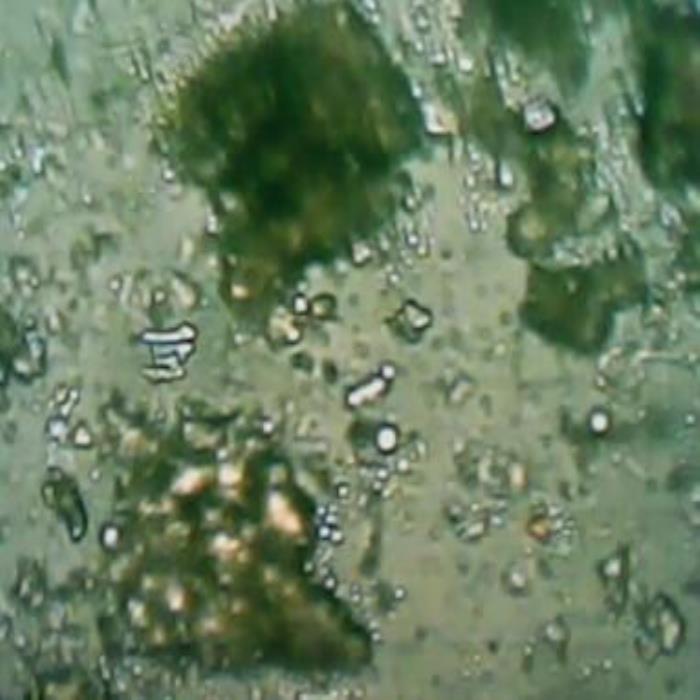
C) Fragments of seed
- A. A fragment of the seed showing the seed testa with the characteristic epidermis composed of a yellowish to brown palisade cells thickened with rods giving a flame-like appearance (flame cells); the other dark part of the fragment is composed of layers of the sclerenchyma of the testa with thick pitted walls.
- B. A fragment of the seed endosperm showing its yellow-coloured polygonal cells that contain oil droplets.
- C. Fragments of the seed showing different tissues with different types of cells, and cell contents and oil droplets.
Chemical constituents
Constituents of seeds: alkaloids, steroid glycosides and flavonoids (Ambil, 2007). Sterols, citbittol. Glucose and α-spinasterol from fruits and seeds.
(α-elaterin-2D-glucopyranoside) and α-elaterin (cucurbitacin E) and citrullol from pulp. Glycosides in fruit: elaterin, elatericin B (cucurbitacin I) and dihydroelatericin B (cucurbitacin L). Myristic, palmitic, stearic, myristoleic, palmitoleic, oleic, linoleic acids and citrullonol from seed oil. Hentriacontane, n-octacosanol and 1,26-hexacosanediol. Linoleic (51.3), oleic (24.1), palmitic (12.8) and stearic acids (9.8%) in seed oil.
Cucurbitacins B, E, I, cucurbitacin E-2 glucoside, Quercetin and kaempferol in leaves, fruits and flowers. Hentriacontane, elateridine, hexanorcucurbitacin I and its 16-O-acetyl derivative and Cucurbitacin T from fruits. glycoside as 2-Oβ-D-glucopyranosyl-22,23,24,25,26,27- hexanorcucurbitacin I and 2-O-β-D-glucopyranosylcucurbitacin I, and 2-O-β-D-glucopyranosylcucurbitacin E and 2-O-β-D-glucopyranosylcucurbitacin L (Rastogi, 1990, 1991,1993, 1995, 1998).
Glycosides: elaterin (cucurbitacin E), elatericin B (cucurbitacin I) and dihydroelatericin B (cucurbitacin L). (Lavie, 1964).
Cucurbitacin glycosides: 2-O-β-d-glucopyranosyl-cucurbitacin I, 2-O-β-d-glucopyranosyl-cucurbitacin E, 2-O-β-d-glucopyranosyl-cucurbitacin L and the novel glycoside, 2-O-β-d-glucopyranosyl-(22–27)-hexanorcucurbitacin I. (Natiq ,1989). Flavones C-glycosides in the fruits which contained: isovitexin, iso-orientin, iso-orientin 3'-methyl ether. (Galal, 1997). Flavone glucosides in the fruits: isosaponarin, isovitexin and isoorientin 3’-O-methyl ether. Two cucurbitacin glucosides: 2-O-β-D-glucopyranosylcucurbitacin I and 2-O-β-D-glucopyranosyl cucurbitacin L. (Delazar, 2006).in fruits: 2-O- β-D-glucopyranosyl cucurbitacin E. (Torkey, 2006).
The following chemical studies have been carried out (Quality Control methods, 1998; Evans, 1996) on the seeds of Citrullus colocynth (ZCHRTM unpublished work):
Physicochemical Constants
Loss of weight on drying at 105°C: 6.20
Absolute alcohol solubility: 18.80
Water solubility: 6.85
Successive extractives (%)
Petroleum ether (60-80) °C : 1.96
Chloroform : 1.70
Absolute alcohol : 2.85
Ash values (%)
Total ash : 2.49
Water soluble ash : 1.17
Acid insoluble ash (10% HCl) : Nil
pH values (aqueous solution)
pH of 1% solution : 5.846
pH of 10% solution : 5.697
Elemental analyses
Ash values (British Herbal Pharmacopeia)
Assay and identification of metal (AOAC International)
|
Apparatus |
AA-6800 Shimadzu-Flame method |
||||
|
Element |
Std. conc. µg/ml(ppm) |
Sample conc.mg/ml |
Samples absorbance |
Actualconc.mg/ml |
Actual conc. (%) |
|
Cr |
1, 2, 4 |
20.056 |
0.0000 |
0.00000 |
0.00000 |
|
Zn |
0.5, 1, 2 |
20.056 |
0.1055 |
0.050555 |
0.0050555 |
|
Cu |
0.5, 1, 2 |
20.056 |
0.0198 |
0.0094450 |
0.009445 |
|
Fe |
1, 2, 4 |
20.056 |
0.0104 |
0.0199350 |
0.0019935 |
|
K |
1, 2, 4 |
20.056 |
1.5608 |
0.883215 |
0.0883215 |
|
Pb |
1, 2, 4 |
20.056 |
0.0024 |
0.01265 |
0.001265 |
|
Cd |
0.25, 0.5, 1 |
20.056 |
0.0000 |
0.0000 |
0.0000 |
UV Spectral studies
|
Ultraviolet Spectrum (USP) |
||||
|
Apparatus |
Milton Roy Spectronic Genesys 5 Spectrophotometer - Milton Roy. |
|||
|
Sample conc. (mg / ml) |
Solvent |
λ max (nm) |
λ min (nm) |
Abs.( λ max - λ min) |
|
4. 6 |
Intestinal Fluid simulated without pancreatic pH=7.50.1 |
274 |
259 |
1.008 - 0.957 |
|
- |
Gastric Fluid simulated without pepsin pH =1.20.1 |
no shift |
no shift |
- |
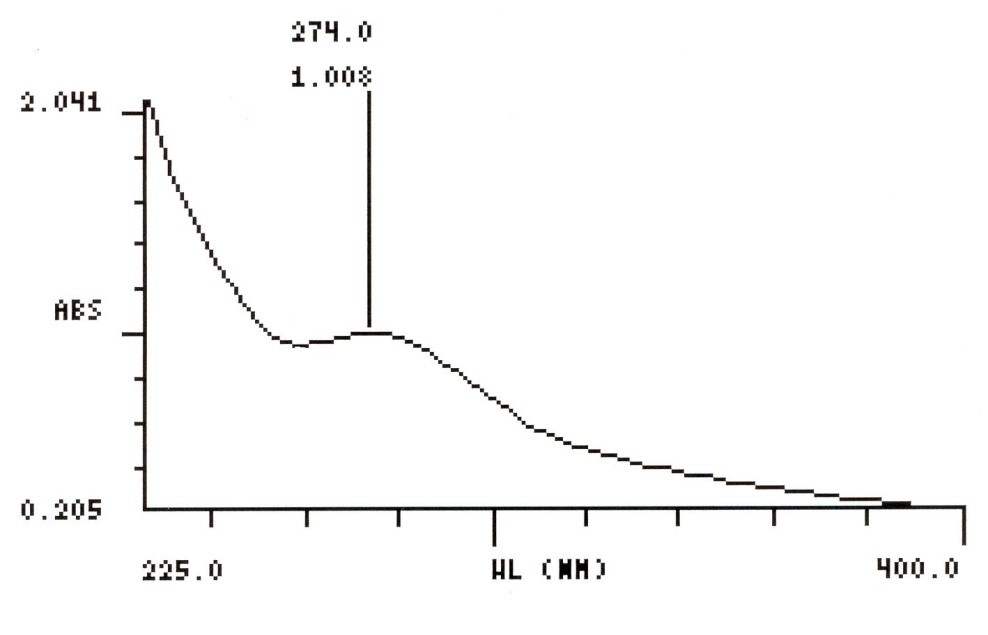
Intestinal Fluid simulated without pancreatic
Chromatographic Studies
Thin layer chromatography (Wagner and Bladt, 1996)

A
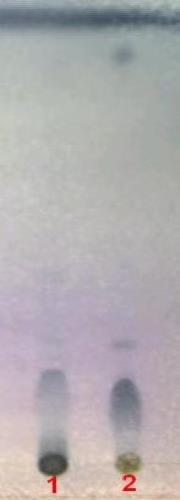
B
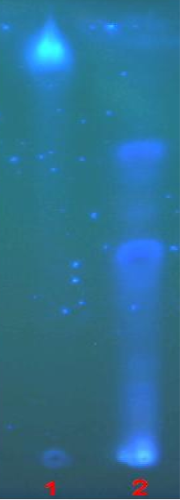
C

D
TLC fingerprint of Pet. ether (60-80) °C extract (track 1) and MeOH extract (track 2)
|
Mobile phase Fig. |
A, C&D |
: |
Ethyl acetate, methanol, water (100:13.5:10) |
|
|
B |
: |
Toluene, ethyl acetate (93:7) |
|
Detection |
A |
: |
UV 254nm |
|
|
C |
: |
UV 365nm |
|
Derivatization |
B&D |
: |
Vanillin-Sulphuric acid-vis |
Pharmacological and toxicological studies
A brief review of the important pharmacological and toxicological activities of the plant Citrullus reported in various scientific journals are presented below:
The methanolic extract from the fruit of Citrullus colocynthis showed an inhibitory effect on ear passive cutaneous anaphylaxis reactions as a type I allergic model in mice (Yashikawa, 2007). C. Colocynthis pulp extract is a well-known laxative (Lorenze, 2005). In the UAE, many traditional plants such as the Citrullus colocynthis (Handal) are used as antidiabetic remedies. The plasma level of alanine amino transferase (ALT), alkaline phosphatase (ALP), aspartate aminotransferase (AST), gamma-glutamyl transferase (GGT), and lactic dehydrogenase (LDH) increased significantly after the onset of diabetes. Oral administration of the plant extract reduced the plasma level of AST and LDH significantly. However, the plant extract failed to reduce the increased blood level of GGT and ALP in diabetic rats. Blood urea nitrogen (BUN) increased significantly after the onset of diabetes. No significant difference was observed in the blood creatinine, K+, Na+, Ca2+ and P levels of normal and diabetic rats. The plant extract did not have any effect on BUN level; however, it caused an increase in the level of K+, Na+ in diabetic rats. In conclusion, oral administration of the aqueous extract of the C. colocynthis can ameliorate some of the toxic effects of streptozotocin (Al-Ghaithi ,2004).
A crude 50% ethanol extract of Citrullus colocynthis was administered orally to male albino rats for evaluation of antifertility effects. A 50% ethanol extract of C. Colocynthis showed an anti-androgenic nature, thereby reducing reversible infertility in male albino rats (Chaturvedi, 2003).
Feeding a mixture of C. colocynthis caused more pronounced effects and death of rats. Vital organ lesions accompanied by anaemia and leucopenia were correlated with changes in serum ALP, AST and ALT activities with alterations in concentrations of total protein, albumin, urea and other serum constituents. Serum bilirubin concentration did not change (AL-Qarawi , 2003). Citrullus colocynthis extract was found to be free of hepatotoxic effects in concentrations up to 100 microg/ml incubation mixture when liver slices were incubated in William's medium E for 22 hours. Carbon tetrachloride induced hepatotoxicity could not be prevented or alleviated. Moreover, the damage was sometimes enhanced by higher extract concentrations (Barth, 2002).
Infusions of Citrullus colocynthis Schrad (Cucurbitaceae) fruits are traditionally used as antidiabetic medication in Mediterranean countries. The present study showed that different Citrullus colocynthis seed extracts have an insulinotropic effect which could at least partially account for the antidiabetic properties of these fruits. Aqueous extract of the rind of C. colocynthis possesses a hypoglycemic effect, which could be attributed to a greater extent to the presence of saponin (Abdel-Hassan, 2000). The plant has been reported to possesses anti-diabetic; diuretic, anti-epileptic, anti-blennorrhea properties, and act against gout and ascites. (Guiso Gallisai, 2002).
Acute toxicity and histopathological effects of saponin (extracted from the plant Citrullus colocynthis) on mice was assessed. The median lethal dose (LD50) of the saponin was 200 mg/kg b.wt. The histological changes were confined to the small intestine, liver and kidney, whereas the stomach, large intestine and heart appeared normal (Diwan, 2000).
Oral administration of 0.25 g/kg/day dose of C. colocynthis fruits or 0.25 g/kg/day of R. stricta leaves for 42 days proved to be not fatal. However, that the mixture of the two plants (0.25 g + 0.25 g/kg/day) proved fatal within 26 days with profuse diarrhea, dehydration, loss in condition, ataxia and recumbence, prior to death (Adam et al., 2000). Feeding the mixture of C. colocynthis and N. oleander caused more marked effects and death of rats (Al-Yahya, 2000).
The following pharmacological and safety evaluation studies were carried out on the aqueous extract of the plant Citrullus colocynthis (Derelanko, 2002; Han, 2003):
|
ACTIVITY |
RESULTS |
|||
|
Strong |
Moderate |
Mild |
Negative |
|
|
Anti-diabetic |
√ |
|
|
|
|
Analgesic |
√ |
|
|
|
|
Antidepressant |
|
|
|
√ |
|
Effect on rabbit jejunum |
√ |
|
|
|
|
Effect on rat fundus |
√ |
|
|
|
|
Effect on Guinea pig ileum |
√ |
|
|
|
|
Effect on right rat atria |
|
√ |
|
|
|
Locomotor ↓ |
√ |
|
|
|
|
Motor co-ordination & grip strength ↓ |
√ |
|
|
|
|
Rectal temperature ↓ |
√ |
|
|
|
|
Lethality ↑ |
√ |
|
|
|
Summary of the results
The results of the present study suggest that the aqueous extract of the plant possesses significant hypoglycemic effect in mice.

Anti-diabetic activity
The extract showed significant anti-nociceptive activity in the hot-plate test. The plant extract caused a strong spasmogenic activity, which provides a scientific basis for its use in the regulation of bowl function through rapid transit and relieving constipation (laxative activity). Overdose may produce gastrointestinal disturbance (Stomach upset; Diarrhea). The effect on isolated rat fundus showed the purgative nature of the plant extract. Also, the plant extract showed a positive inotropic effect increasing myocardial contractility when used to support cardiac function. The plant extract did not show the anti-depression activity. Oral administration of the plant extract at 200 and 250 mg/kg was not fatal but showed profuse diarrhea, gross lack of coordination of body movement and showed state of leaning, resting, or reclining.
Antimicrobial activity
The aqueous extract of the whole plant was tested against Mycobacterium smegmatis, C. tropicalis, different strains of Methicillin Resistant Staphylococcus aureus, different strains of ESBL-producing K. pneumonia, E. coli, Pseudomonas aeruginosa. The extract significantly inhibited the growth of Mycobacterium smegmatis and showed weak antibacterial activity against ESBL-producing E. coli, Pseudomonas aeruginosa.
References
- Abdel-Hassan IA, Abdel-Barry JA, Tariq Mohammeda S. The hypoglycemic and antihyperglycaemic effect of Citrullus colocynthis fruit aqueous extract in normal and alloxan diabetic rabbits. J Ethnopharmacol,. 2000 71:325-30.
- Adam SEI , Al-Farha AH, Al-Yahya A. Effect of combined Citrullus colocynthis and Rhazya stricta use in Najdi sheep. Am J Chin Med, 2000, 28:385-390.
- Al-Ghaithi F, El-Ridi MR, Adeghate E, Amiri MH. Biochemical effects of Citrullus colocynthis in normal and diabetic rats. Mol Cell Biochem, 2004, 261:143-269.
- AL-Qarawi AA, Adam SE. Effect of combination of Capsicum frutescens and Citrullus colocynthis on growth, haematological and pathophysiological parameters of rats. Phytother Res, 2003, 1:92-5.
- Al-Yahya MA, AL-Farhan AH, Adam SE. Preliminary toxicity study on the individual and combined effects of Citrullus colocynthis and Nerium oleander in rats. Fitoterapia. 2000, 71:385-391.
- Ambi1, A. A., Abdurrahman, E. M M, Sule, I. . Pateh, U. U Abdurrahman Y. R. and Ibrahim N. D. G.,Phytochemical Screening and Histopathological Studies on the Seeds of Colocynthis Citrullus in Albino Rats . Nig. Journ. Pharm. Sci., October, 2007, Vol. 6 No. 2, P. 7 – 13.
- Barth A, Müller D, Dürrling K. In vitro investigation of a standardized dried extract of Citrullus colocynthis on liver toxicity in adult rats. Exp Toxicol Pathol, 2002, 54:223-230.
- Batanouny, K.H. et al. Wild medicinal plants in Egypt – an inventory to support conservation and sustainable use. The Palm Press, Egypt, p.42, 1999.
- Delazar, A., Gibbons, S., Kosari, A. R., Nazemiyeh, H., Modarresi, M., Nahar, L., Sarker, S. D. Flavone C-glycosides and cucurbitacin glycosides from Citrullus colocynthis. Tehran University of Medical Sciences DARU Volume 14, No. 3, 2006 p. 109- 114.
- Diwan FH, Abdel-Hassan IA, Mohammed ST. Effect of saponin on mortality and histopathological changes in mice. East Mediterr Health J. 2000, 6:345-351.
- El-Ghonemy, A. A. (1993). Encyclopedia of Medicinal plants of the United Emirates. 1st Edition. University of U.A.E.
- Fawzi, M. K. (1995). Weeds in the United Arab Emirates. University of U.A.E.
- Flora of Pakistan; www.efloras.org
- Galal T. Maatooq, Saleh H. El-Sharkawy, M. S. Afifi and Jack P. N. Rosazza. C-p-hydroxybenzoylglycoflavones from Citrullus colocynthis. Phytochemistry Volume 44, Issue 1, January 1997, Pages 187-190.
- Guiso Gallisa F.Information In: Sincich, F. 2002. Bedouin Traditional Medicine in the Syrian Steppe. Rome, FAO. 114-115.
- Jonbloed, M. V., Feulner, G. R., Boer, B. & Western, A. R. (2003). The comprehensive Guide to the Wild Flowers of the United Arab Emirates, Erwda, Abu Dhabi, U.A.E.
- Lavie, D. Willner, D. and Merenlender, Z. Constituents of Citrullus colocynthis (L.) Schrad. Phytochemistry Volume 3, Issue 1, January 1964, Pages 51-56.
- Lorenz PR, Lippmann F, Dürrling K, Solf M, Geissler J. Pharmaco-toxicological and clinical studies with colocynthis pulp extracts Arzneimittelforschung, 2005, 55:621-663.
- Mandaville, J. P. (1990). Flora of Eastern Saudi Arabia. Kegan Paul International, Riyadh, Saudi Arabia.
- Miller, A. G. and M. Morris . 1988. Plants of Dhofar, The Southern Region of Oman. Traditional Economic and Medicinal Uses. Diwan of Royal Court Sultanate of Oman—Holmes MC Dougall, Edinburgh, Scotland.
- Natiq A.R. Hatam, Donald A. Whiting and Nahia J. Yousif. Cucurbitacin glycosides from Citrullus colocynthis. Phytochemistry. Volume 28, Issue 4, 1989, Pages 1268-1271.
- Nmila R, Gross R, Rchid H, Roye M, Manteghetti M, Petit P, Tijane M, Ribes G, Sauvaire Y. Insulinotropic effect of Citrullus colocynthis fruit extracts. Planta Med, 2000, 66:418-423.
- Rastogi & Mehrotra, Compendium of Indian medicinal plants : vol. 1, PID, New Delhi,1990,p.105.
- Rastogi & Mehrotra, Compendium of Indian medicinal plants : vol. 2, PID, New Delhi,1991,p.185.
- Rastogi & Mehrotra, Compendium of Indian medicinal plants : vol. 3, PID, New Delhi,1993, p.174.
- Rastogi & Mehrotra, Compendium of Indian medicinal plants : vol. 4, PID, New Delhi,1995, p.188.
- Rastogi & Mehrotra, Compendium of Indian medicinal plants : vol. 5, PID, New Delhi,1998, p.210.
- Shahina A. Ghazanfar. (1994). Handbook of Arabian Medicinal Plants. CRC Press.
- Western, A. R. (1986). The Flora of United Arab Emirates. An introduction. –Al Ain.
- Western, A. R. (1989). The Flora of United Arab Emirates. An introduction. Publications of the U.A.E. University.
- Yoshikawa M Morikawa T, Kobayashi H, Nakamura A, Matsuhira K, Nakamura S, Matsuda H. Bioactive saponins and glycosides. XXVII. Structures of new cucurbitane-type triterpene glycosides and antiallergic constituents from Citrullus colocynthis. Chem Pharm Bull, 2007, 55:428
